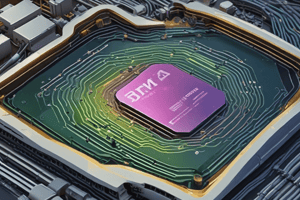Podcast
Questions and Answers
What is the primary function of a file server in a network?
What is the primary function of a file server in a network?
- To maintain the print queue for all users
- To contain documents used by other computers (correct)
- To provide instant messaging services
- To connect peripheral devices directly to users
Which of the following best describes a Local Area Network (LAN)?
Which of the following best describes a Local Area Network (LAN)?
- A network that spans multiple cities and connects various organizations
- A network containing computers that are widely distributed geographically
- A decentralized network shared among public resources
- A network typically confined to a single office or building (correct)
What is a primary advantage of shared peripheral devices in a network?
What is a primary advantage of shared peripheral devices in a network?
- They reduce the overall cost per user (correct)
- They increase the complexity of network management
- They improve the speed of data transfer between computers
- They enhance the individual user’s data storage
Which hybrid network type is characterized by its large geographic coverage but limited to resources shared within an organization?
Which hybrid network type is characterized by its large geographic coverage but limited to resources shared within an organization?
Which of the following accurately describes Voice over IP (VoIP)?
Which of the following accurately describes Voice over IP (VoIP)?
What is a key characteristic of a Wide Area Network (WAN)?
What is a key characteristic of a Wide Area Network (WAN)?
What does a print server do in a network setting?
What does a print server do in a network setting?
Which network type is primarily designed for connecting personal devices over short distances?
Which network type is primarily designed for connecting personal devices over short distances?
What advantage does networked software sharing provide organizations?
What advantage does networked software sharing provide organizations?
Which of the following methods is NOT commonly used for backing up data on a network?
Which of the following methods is NOT commonly used for backing up data on a network?
What is the primary function of a server in a server-based network?
What is the primary function of a server in a server-based network?
In a client/server network, what roles do the nodes typically assume?
In a client/server network, what roles do the nodes typically assume?
Which topology is characterized by a central connection point that can become a single point of failure?
Which topology is characterized by a central connection point that can become a single point of failure?
What is a major disadvantage of a bus topology?
What is a major disadvantage of a bus topology?
What distinguishes a mesh topology from other topologies?
What distinguishes a mesh topology from other topologies?
Which type of cabling technology is primarily utilized for local area networks (LANs)?
Which type of cabling technology is primarily utilized for local area networks (LANs)?
What protocol simplifies the dynamic assignment of IP addresses in a network?
What protocol simplifies the dynamic assignment of IP addresses in a network?
What is the primary characteristic of a ring topology?
What is the primary characteristic of a ring topology?
How does a switch function compared to a hub in a network?
How does a switch function compared to a hub in a network?
What is a disadvantage of using fiber-optic cabling?
What is a disadvantage of using fiber-optic cabling?
Which statement best describes the role of a router in a network?
Which statement best describes the role of a router in a network?
Which medium is known for being nearly obsolete due to its lower speeds?
Which medium is known for being nearly obsolete due to its lower speeds?
In which type of network does each node control its own resources?
In which type of network does each node control its own resources?
What is the maximum bandwidth of Fast Ethernet technology?
What is the maximum bandwidth of Fast Ethernet technology?
Flashcards are hidden until you start studying
Study Notes
Network Basics
- A network consists of technologies that link computers, enabling communication and collaboration.
- Data can be accessed simultaneously by multiple users with shared files stored on servers.
Uses of a Network
- Files and software can be shared, with access levels set as needed.
- Networked peripheral devices, like printers or faxes, reduce costs and are managed through print servers.
- Personal communication tools include email, teleconferencing, videoconferencing, and VoIP (Voice over IP).
Data Management
- File servers hold documents shared across various computers.
- Networks facilitate simpler data backup through consolidated server backups.
Common Network Types
- Local Area Network (LAN): Typically confined to an office, connecting computers, printers, and servers.
- Wide Area Network (WAN): A larger network connecting multiple LANs, often using public or leased lines; the Internet is the largest WAN.
- Campus Area Network (CAN): A LAN that spans a large geographic area, shared by various departments within an organization.
- Metropolitan Area Network (MAN): Connects multiple organizations within a region, sharing resources.
- Home Area Network (HAN): Connects devices in a home environment, like computers and entertainment systems.
- Personal Area Network (PAN): A very small network, usually under 2 meters, including personal devices like smartphones and MP3 players.
Network Structures
- Server-based Network: Centralized control by servers determining node access.
- Client/Server Network: Nodes act as clients, sharing data while the server regulates access.
- Peer-to-Peer Networks (P2PN): Equal nodes that control their resources and share directly with one another, ignoring server oversight.
Network Topologies
- Topology defines the layout of the network which affects performance and size.
- Packets are data pieces transmitted across the network, containing headers (addresses) and payload (data).
- Bus Topology: All nodes connect to a single wire; easy to set up but slow and prone to crashes.
- Star Topology: Nodes connect to a central hub; most common but vulnerable if the hub fails.
- Ring Topology: Nodes form a circle; token-based data transmission prevents collisions but is slower.
- Mesh Topology: All nodes interconnect; highly reliable but complex to set up.
Network Media
- Links between nodes can vary in terms of speed, security, and size.
- Wired Media:
- Twisted-Pair Cabling: Common in LANs; speeds from 1 Mbps to 1,000 Mbps.
- Coaxial Cable: Used for earlier networks; speeds up to 10 Mbps, largely obsolete.
- Fiber-Optic Cable: High-speed data through light; secure and immune to interference, reaching speeds up to 100 Gbps.
- Wireless Media: Data transmitted via radio or microwave signals; easy to set up but harder to secure.
Network Hardware
- Network Interface Cards (NIC): Enable node connectivity via a unique MAC address.
- Hubs: Centralizing nodes in star topology; less efficient and secure.
- Switches: Superior to hubs; single transmissions, enhancing speed and security.
- Bridges: Connect multiple LANs and segment traffic based on MAC addresses.
- Routers: Connect LANs and segment networks based on IP addresses; essential for Internet connectivity.
- Gateways: Interface between different network types, converting signals as needed.
Network Cabling
- Bandwidth and cable length directly affect network performance.
- Ethernet: Popular technology, max bandwidth of 10 Mbps over distances of 100-500 meters.
- Fast Ethernet: Up to 100 Mbps; requires Cat5 or better cabling.
- Gigabit Ethernet: Achieves 1 to 10 Gbps for high-throughput applications.
- Token Ring: Uses twisted-pair cabling with speeds of 10-25 Mbps, common in certain industries.
Network Protocols
- Protocols are communication rules that determine how data is handled on networks.
- TCP/IP: The most widely-used protocol; comprises Transmission Control Protocol and Internet Protocol for identifying machines via IP addresses.
- IPX/SPX: An older protocol tied to Novell Netware, largely replaced by TCP/IP.
- NetBEUI: Used in Windows networks for name recognition; works alongside TCP/IP.
- Token Ring Protocol: Nodes pass a token to communicate, ensuring orderly data transmission.
Studying That Suits You
Use AI to generate personalized quizzes and flashcards to suit your learning preferences.




